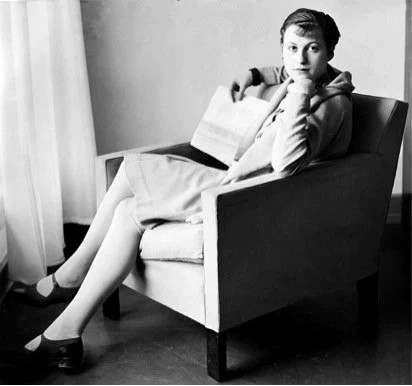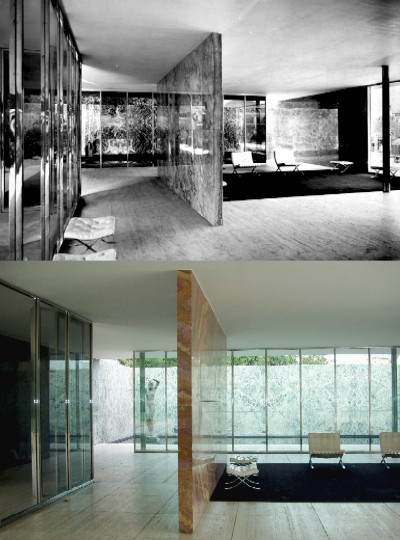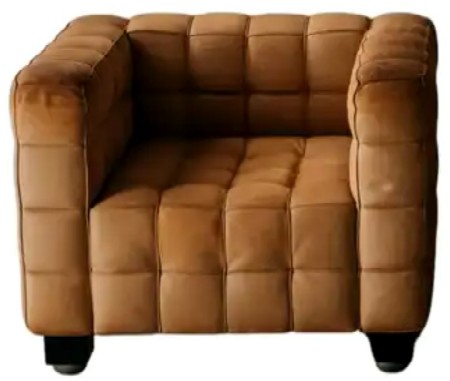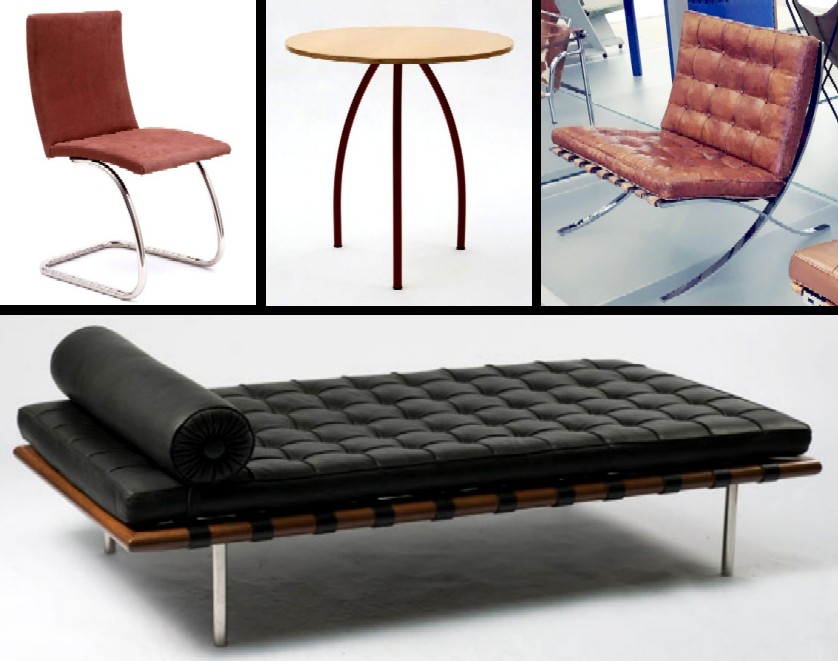
Lilly Reich (1885 - 1947)
Lilly Reich designed textiles, furniture, interiors,

Lilly Reich
and exhibition spaces during her life. Her work was heavily involved with German Bauhaus style furniture. While Bauhaus had a great deal of impact on the Streamline Moderne artists in America, it is technically a different, being one of the styles which advanced the Modernist idea of form over function in a manner even more pronounced than Streamline Moderne. Yet, the two styles have a great deal in common.
Reich left Berlin in 1908 at the age of 23 after training to be an industrial embroiderer, moving to Vienna, Austria. There she began her career in architect Josef Hoffmann's Wiener Werkstatte (Vienna Workshop). The workshop was one of the pioneers of Modernism, employing artists working in a variety of different media to produce utilitarian objects. There Reich expanded her skills, working with textiles and interior design. "Through this early experience she gained a mastery of texture, color, and how the human body occupies space—skills that informed projects throughout her career." (Paul Galloway, "Lilly Reich, German, 1885–1947", MoMA, gathered 6-17-24) hShe worked with Hoffman on the design of the Kubus armchair and sofa.
She returned to Berlin in 1911 and opened a successful studio which designed women's clothing, textiles and furniture. Here Reich took particular interest in the way contrasting textures and materials worked together and how they could be used in furniture. She also designed window displays for fashionable department stores which helped establish her as an influential designer. She was elected to the German Werkbund (German Work Federation) in 1912. a group formed to combine art and industry in the creation of German products. This presages the industrial design philosophy which was to be so important to the Streamline Moderne movement. In 1914, she was the first woman to voted to the governing board of the Werkbund.
In 1924 Reich closed her shop and began working at the Frankfurt am Main Trade Fair Office organizing and designing trade fairs. Here she met Ludwig Mies van der Rohe, the vice president of the Werkbund and a pioneers

Barcelona Pavillion, 1929 and 1986, Chicago Collections and Wikimedia
of Modernism. The two started a personal and professional relationship, collaborating on a variety of projects including items for exhibitions, contracted jobs and furniture. Many of their furniture designs are still in production today, attesting to its longevity.
"Reich and Mies's partnership on furniture, building, and exhibition projects changed both their practices, resulting in an injection of bold individualistic styles, which emphasized dramatic uses of color and luxury materials, into the functionalist program that dominated modern architecture and design." (moma.org) A highlight of their collaboration was his Pavilion at the Barcelona World Exposition where she was listed in the official program as the Artistic Director of the German Section.
The Barcelona Pavilion... was the German Pavilion for the 1929 International Exposition in Barcelona, Spain. This building was used for the official opening of the German section of the exhibition. It is an important building in the history of modern architecture, known for its simple form and its spectacular use of extravagant materials, such as marble, red onyx and travertine. Furnishings specifically designed for the building, including the Barcelona chair, are still in production. It has inspired many important modernist buildings. The original structure was demolished in 1930, and the existing reconstruction was completed in 1986. ("Barcelona Pavillion", Wikipedia, gathered 6-17-24)
"She is widely acknowledged with collaborating on, if not wholly designing, the famous furniture designed for the Barcelona Pavilion." (tipsy modernist, "Lilly Reich. Designer. Architect. Hero.", The Modernists Guide to Cocktails website, gathered 6-17-24) In researching Reich, Albert Pfeiffer says that "It became more than a coincidence that Mies's involvement and success in exhibition design began at the same time as his personal relationship with Reich... It is interesting to note that Mies did not fully develop any contemporary furniture successfully before or after his collaboration with Reich." ("Lilly Reich", Wikipedia, gathered 6-17-24)

Kubus Armchair, Designed with Josef Hoffman, Leather and Wood, c. 1960, 1st
Dibs. Reich helped design this chair, although it is often credited only to him.
van der Rohe was involved in avant-garde design school Bauhaus as director of architecture in the 20s. In 1930, he became the director of the school at the request of its founder Walter Gropius. He invited Reich to teach furniture and interior design and head the interior finishing department which oversaw weaving, wall painting, metalwork and cabinetry in 1932. She was also involved managing daily administration. Unfortunately, the Third Reich closed the school in 1933.
The pair continued to display at exhibitions until Mies emigrated to the United States in 1938 to teach and escape the war. She visited him in Chicago in 1939 at the Illinois Institute of Technology, but returned to Germany to keep their business going and safeguard their design archives.
There was little work in Germany for her during the war, however. A Bauhaus student working for Nazi architect Albert Speer got her a job. In 1943, Reich's studio was bombed and she was sent to a forced labor camp. After the war, she taught at Universität der Künste in Berlin, but had to resign in 1945 due to poor health. She died in 1947.
Shown below are several examples of furniture which Reich co-designed with van der Rohe. The style of this furniture endures and, as a result, many of the examples of it are modern, based on the original designs.
Sources Not Mentioned Above:
Lars Bülow, "Lilly Reich - The woman behind Mies furniture design successes", Mobel Design Museum, gathered 6-17-24
"Wiener Werkstätte" Wikipedia, gathered 6-17-24
"Walter Gropius", Wikipedia, gathered 6-17-24
Matilda McQuaid, "Lilly Reich: designer and architect", The Museum of Modern Art, pdf gathered 6-17-24
Laura Lizondo-Sevilla, "Lilly Reich: The architecture and critique of an invisibilized woman", Frontiers of Architectural Research, Vol. 12, Issue 1, Gathered from Science Direct website, 6-17-24
David Caralt, "Worth Knowing - Lilly Reich: The Barcelona Exhibition in 1929", Fundación Arquitectura y Ciudad gathered 3-17-26)
Original Facebook Group Profile
 Lilly Reich Furniture, from left - LR120 Cantilevered Armless Chair, The Knoll Group, Nickel Plated Steel Tubing and Leather, Designed with Mies van der Rohe, c1931, MoMA; Lilly Reich, LR500 Garden Table, Birch Veneer Over Plywood and Tubular Steel, Reproduction by Shea & Latone, Inc., Designed - with Mies van der Rohe, c1931, MoMA; MR90 Barcelona Chair, Designed with Mies van der Rohe, Leather and Metal, 1929, reddit; Daybad with Tufted Cushion and Pillow, Designed with Mies van der Rohe for Philip Johnson, 1930, Core77
Lilly Reich Furniture, from left - LR120 Cantilevered Armless Chair, The Knoll Group, Nickel Plated Steel Tubing and Leather, Designed with Mies van der Rohe, c1931, MoMA; Lilly Reich, LR500 Garden Table, Birch Veneer Over Plywood and Tubular Steel, Reproduction by Shea & Latone, Inc., Designed - with Mies van der Rohe, c1931, MoMA; MR90 Barcelona Chair, Designed with Mies van der Rohe, Leather and Metal, 1929, reddit; Daybad with Tufted Cushion and Pillow, Designed with Mies van der Rohe for Philip Johnson, 1930, Core77